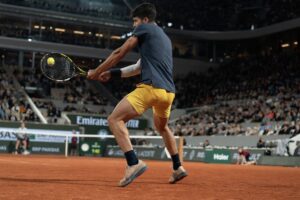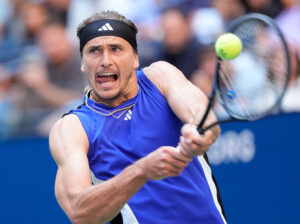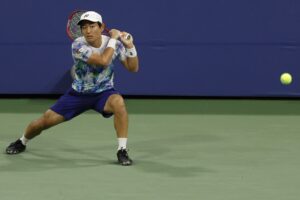Paris ’68 was such a remarkable, revolutionary time that the phrase itself has become a kind of shorthand for any momentous period in world history. As workers and students took to the streets of the French capital, some of them “demand (ing) the impossible” (as the famous slogan from the time put it), it seemed that France was undergoing a second revolution–one that threatened, for a while at least, the Government of the great WW2 leader, Charles de Gaulle. Indeed, so turbulent were the events that at one point de Gaulle allegedly fled the country and there was a brief vacuum of power that threatened to be filled with an entirely new kind of ruling class. And in the midst of all this genuine social, political and economic upheaval, tennis underwent its own much smaller revolution.
Paris ’68 did not happen in isolation. Instead, it was sparked off by a number of other social and political revolts around the world and then, in turn, it acted as a kind of lightning conductor for almost all the other great expressions of global discontent that were being made at the time. Its most obvious antecedent was the “Prague Spring,” another contemporary phrase that continues to have enormous resonance today. However, unlike “Paris ‘68,” “Prague Spring” was something of a misnomer, in that the period of political liberalisation in Czechoslovakia that gave rise to it actually began in January 1968 and continued until August, when the Soviet Union finally sent in tanks to crush the most serious uprising in the Communist bloc since Hungary in 1956.
The other truly historic event that helped to feed the fires that would eventually consume much of Paris was the Tet Offensive in Vietnam. Like the Prague Spring, the Tet Offensive actually began in January 1968 and rumbled on until the autumn. The South Vietnamese army and the hundreds of thousands of US soldiers sent to support them eventually repelled the North Vietnamese attack. However, there were enormous casualties on both sides and the horrific fighting and even more horrific imagery of mass displacement and casual brutality truly thrust the Vietnam war, which had already been going on for more than a decade, onto television screens around the world. In the West, there were mass protests against the war, with even Mick Jagger marching on the US embassy in London, an event that would eventually trigger one of the Rolling Stones’ greatest songs, “Street Fighting Man.” And in what was then called “the Third World” (to differentiate it from the “first world” of capitalism and the “second world” of Communism), there were a series of mass uprisings against colonial powers and their local ruling elites, from Africa to Latin America.
Like so much of the sixties, 1968 was soundtracked and captured on film by numerous truly revolutionary artists, who responded to the historic events they were witnessing by creating some of their greatest work. To give but two examples, the Rolling Stones finally emerged from the Beatles’ enormous shadow by producing their first classic album, “Beggars Banquet” (featuring the aforementioned “Street Fighting Man”), and Jean-Luc Godard, the great French film-maker, produced arguably his last true masterpiece, “Week-End”, which was released in 1967 but imaginatively prefigured the tumultuous events that would engulf Paris a year later.
Finally, at the beginning of May 1968 in Paris, all of these different social, political, and even artistic currents seemed to converge in a flood of unrest and activism that briefly threatened to overwhelm one of the world’s wealthiest and most powerful countries. And at the same time, although it must have seemed relatively insignificant in comparison with the events taking place in the streets of Paris, the grand old clay courts of Roland Garros were the setting for a much smaller but none the less historic sporting revolution.
For decades, tennis had had an almost schizophrenic nature, with the sport’s greatest events–the four Majors in Paris, London, New York, and Australia–only allowing amateur players to participate, while most of the greatest players in the world (and certainly all those who were not independently wealthy) being refused entry. Instead, they were forced to make their living on the “professional” circuit, which mainly consisted of long series of exhibition matches in North America. So, from Fred Perry in the late 1930s to Rod Laver in the early 1960s, most of the best tennis players in the world would make their name by winning “amateur” Majors before hastily turning professional to try and make some money to go alongside their burgeoning fame.
Ultimately, this split in the sport’s DNA was unsustainable. By the late 1960s, when so many of the greatest tennis players were being prevented from playing in the Majors, pressure had been mounting for many years to finally end the division between the “amateur” and “professional” sides of tennis and allow all tennis players, if they were good enough, to compete for the biggest prizes.
In part, this was because tennis in particular and sport in general were no more immune than any other part of society from the kind of social revolution that had been going on, particularly in the West, since the end of WW2. With the birth of “consumerism” and the sudden ability of previously oppressed or downtrodden social classes, or at least members of those social classes, to “make something” of themselves–which was probably most spectacularly evident in the world of music; almost everyone wanted to cast off the old and embrace the new.
It is ironic, therefore, that probably the final nail in the coffin for the old amateur world of tennis was provided by what had always been regarded as the ultimate bastion of tradition and even conservatism in the sport, namely the greatest tennis championship in the world–Wimbledon. In December 1967, the British Lawn Tennis Association (as the UK’s governing body was called at the time) finally defied the International Lawn Tennis Federation (as the world’s governing body was then known). After an overwhelming vote in favour of “opening” up the game to professionals, it announced that from the following year Wimbledon would allow professionals to participate. As Derek Penmam, a spokesman for the British association made clear, this was largely because the split within tennis had become too deep and too damaging. As Penmam put it, “We must take action on our own account to make the game honest. For too long now, we have been governed by a set of amateur rules that are quite unenforceable.”
Where Wimbledon led, the other Majors soon followed. Indeed, the Australian, US, and French events were soon renamed “Opens,” rather than the “Championships” that they had been before. However, in 1968, as for much of its history, Australia’s Major took place at the end of the calendar year rather than at the start, and so the first “Open-era Major” took place not in Melbourne but in Paris.
Thus it was that almost exactly half a century ago, two revolutions–one a genuine social and political uprising and the other a relatively more sedate sporting upheaval–took place in Paris.
To some extent, the two revolutions remained separate and distinct, with the news media of both France and the wider world naturally focusing on the erection of barricades in the Latin Quarter and other parts of the city by disaffected students and striking workers. By contrast, the few professional tennis writers at the time, including America’s great Bud Collins, largely concentrated on the on-court action rather than reflecting on the far more widespread action by thousands of militants only a few miles away. Consequently, there are relatively few contemporary reports of how the events in the centre of Paris were experienced by those heading out to the tennis. Nevertheless, there were reports of members of the French tennis federation being jostled and heckled by angry protesters as they tried to pass the barricades and marchers on their way to Roland Garros.
On the courts themselves, there was a sense that tennis had finally “healed itself,” even as Paris itself was burning. Finally, the professionals, who had been banned from playing at the Majors and virtually treated as pariahs by the sport that they had helped to popularise, were allowed back in and they were obviously determined to make the most of it. Fittingly, it was two of the greatest male players in the world, Australia’s Ken Rosewall and Rod Laver, who reached the final of the men’s singles. Both men had been forced to play on the professional circuit for many years (in Rosewall’s case, for almost a decade), but once they were allowed back into the mainstream of the game they flourished, as if making up for all the time they had lost. Rosewall would triumph in the first battle of the new “Open” era, winning the 1968 French final in four sets, but ultimately Laver would win the war, by winning a second calendar Grand Slam of all four Majors in 1969, which gave him a “professional” Grand Slam to go alongside the “amateur” one he had achieved in 1962.
Of course, revolutions, by their very nature, are often messy and inconclusive. Just as the riots that had engulfed Paris in May 1968 were eventually quelled by the French Government, after de Gaulle had reasserted his control over the cabinet and the country, so the “tennis revolution” of 1968 did not immediately achieve all of its goals. In fact, tennis experienced a kind of “hangover” state for several years, as the old amateur era came to an end and the new Open era began. That was most obviously manifest in the fact that for the first few years of the “Open” era there was, remarkably, what is still known as the “Open-closed” era, which lasted until about 1972. There were several discrete types of “amateur” and “professional”, or even – incredibly enough – the odd “amateur professional”, with some old stagers, such as another Australian great Lew Hoad, continuing to ply their trade on the old and established professional circuit and only occasionally participating in the new “Open” tournaments that were springing up around the world.
That state of contradiction, which would finally be resolved by the meteoric rise of professional tennis in the 1970s with new and utterly professional stars such as Bjorn Borg and Chris Evert, was embodied in 1968 by the identity of the winner of the women’s singles at Roland Garros. That was America’s Nancy Richey, who defeated Britain’s Anne Jones in the final, 5–7, 6–4, 6–1. However, as Bud Collins pointed out in a 2011 history of the French Open, it was Jones who actually picked up the winner’s cheque, for the princely sum of $1,000. That was because, as Collins put it, Richey was “fearful of giving up her amateur status in that uncertain new year of prize money.” And so the female winner of the first Open-era Major was still an amateur.
Others in this series
Brief History of Pre-1968 Tennis
1968: The Year that Changed Tennis
1968 Wimbledon
1968 US Open
Main Photo:
Embed from Getty Images






